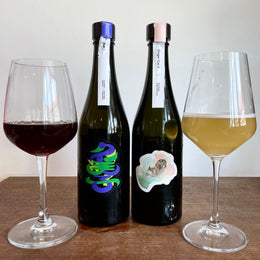
It's been several years since former bartender Tatsuya Motonaga had embarked on producing a made-in-Japan bitters, a liqueur that is of course part of every bartender's essential toolkit and yet has an over-representation in terms of its European sources.
To pre-empt the question of "Why not just make bitters elsewhere then?" - the difficulty lies not in making bitters, but in making quality bitters. Not only does the run-of-the-mill bitter typically feature over 50 ingredients - all of which a closely guarded secret - but there's also the aspect of finding the right proportions, being able to consistently source the multitudes of herbs, roots and flora, at their varying peak of season readiness, and yet when they're all put together, the bitter still has to be able to stand on its own whilst maintaining versatility across a myriad of cocktail recipes. It's a devilishly simple sounding product, that's also perhaps one of the most difficult to create, produce at scale, and consistently.


Tatsuya Motonaga
But that of course won't stop Motonaga, who in preparation had visited over 70 distilleries in Europe, and had taken up stints in some of the best bars in Japan, such as Bar Caol Ila and Bar Benfiddich. With all that experience in hand, Motonaga had thus settled in the rather quiet town of Obara, where he took up residence in a 100-year-old traditional Japanese house. Motonaga began sowing the seeds of the liqueur that was to be - the Scarlet Bitter Liqueur - he would work with local cooperatives and begin growing his various botanicals. The bitter takes its name from the colour pigment derived from cochineal beetles, which were once highly prized around the ancient world for its ability to produce vibrant carmine tones.
| Read: One Man Is Introducing Japan To Its Own Bitters - Iseya Distillery

Once ready, Motonaga then pickles the botanicals - fresh and dried, depending on the herb - and then steeps them in local Japanese vodka, before ageing them in whisky barrels sourced from local Japanese whiskymakers. Thus far much of the work done by Motonaga's Iseya Distillery has been incredibly manual, from cultivating the vast arrays of botanicals, preparing them for use, down to actually producing the liqueur, blending them and bottling them, all of it has been done by hand, which explains why it's been incredibly difficult to get one of Motonaga's bitters - the distillery produces between 1,000 to 1,500 bottles per month, which has only been distributed locally in Japan.

Thus far, since Iseya's formal establishment in 2020, the distillery has expanded to produce a slightly larger set of liqueurs including various versions of its Amaro (such as Menta, Verde, Fernet and Radice). As for its flagship Scarlet Bitter, Motonaga has advanced to producing cask aged blends of the bitter, said to help in rounding out its flavours and maintaining consistency at scale - remember this is a key part of liqueur making! The Scarlet Bitter itself is made from over 20 types of botanicals, which are said to mirror Amaro recipes from the 1800's - Motonaga classifies them into four categories: Grass (Lemon Balm, Goldenberry Sprouts, Sage), Root (Eleuthero, Pampas Grass, Sorrel, Angelica), Wood (Cinnamon), and Peel (Yuzu, Blood Orange).
Today we're incredibly lucky to try a sample of Scarlet's Cask Marriage Bitter, which as mentioned, has been aged for 3 months in ex-Japanese whisky wood barrels.
Let's give this a go!
Scarlet Bitter Liqueur Cask Marriage, ISEYA Distillery - Review

Tasting Notes
Colour: Very Dark Herbal Honey
Aroma: It's incredibly rich, with a mix of roots, honey and cough syrup, all of which is given a big herbal quality. Mint and eucalyptus gives a refreshing aspect to it, with some earthiness of angelica, almost a sort of aromatic tree bark, and then sarsaparilla which brings up an almost chewiness of licorice. There's also more on lacquered wood, burnt orange peels, herbal balms and ointments. It's rich, herbal and sweet, with a pop of natural cola soda with the vibrance and minus the carbonation. Incredibly aromatic and rounded, without being too heavy, bitter or dry.
Taste: Really thick and honeyed here, the richness stays. More herbal roots of angelica, sarsaparilla, leading into root beer syrup and herbal honey. It has a lot of depth, with a rounded and syrupy texture. It has a good complexity to it and feels rather multi-faceted, herbal yet sweet with broad accents of cola.
Finish: More of that organic cola syrup coming through, backed by layers of honey. There's some slightly bittersweet dark chocolate chunks showing up, along with some cinnamon-infused honey. More on those medicinal herbal roots. Not really all that bitter.

My Thoughts
This was incredibly rich and rounded, whilst at the same time vibrant and energetic. It felt like it was buzzing through the syrupy texture and the denseness of the flavours with those bright pops of cola that balances out the herbal sweetness. It's rather exciting to have this even on its own, and made me think of using it in a tonic Highball. What strikes out to me as being more impressive is how layered, cohesive and full bodied this was - it's thicker, richer and more rounded body was incredibly enjoyable.
That said, it's not particularly bitter as it is herbal and at times medicinal, which is worth noting if you're looking for something alot more punchy and intense in its bitterness. That said, I find its mellowness and restraint much more elegant - it feels well-composed of layers of richness that's incredibly cohesive and in amongst those layers are inflections of flavours that gives it its complexity. It somehow feels parallel to Japanese curry which folks tend to find sweeter and less spicy than they might be expecting, and yet it's precisely that distinctive flavour profile that makes it Japanese curry, otherwise it'd just be any other curry. Similarly, I think Scarlet is therefore Japanese bitter, unlike bitter from anywhere else.
Kanpai!

@111hotpot







